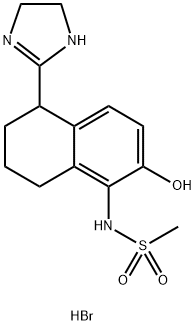A61603臭化水素酸塩

|
- ¥28600 - ¥288000
- 化学名: A61603臭化水素酸塩
- 英語名: A 61603 HYDROBROMIDE
- 別名:A61603臭化水素酸塩
- CAS番号: 107756-30-9
- 分子式: C14H20BrN3O3S
- 分子量: 390.3
- EINECS:
- MDL Number:MFCD02262217
5物価
選択条件:
ブランド
- 富士フイルム和光純薬株式会社(wako)
パッケージ
- 5mg
- 10mg
- 50mg
- 生産者富士フイルム和光純薬株式会社(wako)
- 製品番号W01TRCA101090
- 製品説明
- 英語製品説明A 61603
- 包装単位5mg
- 価格¥28600
- 更新しました2023-06-01
- 購入
- 生産者富士フイルム和光純薬株式会社(wako)
- 製品番号W01TRCA101090
- 製品説明
- 英語製品説明A 61603
- 包装単位10mg
- 価格¥41300
- 更新しました2023-06-01
- 購入
- 生産者富士フイルム和光純薬株式会社(wako)
- 製品番号W01TOC1052
- 製品説明A61603臭化水素酸塩
- 英語製品説明A61603 Hydrobromide
- 包装単位10mg
- 価格¥69000
- 更新しました2024-03-01
- 購入
- 生産者富士フイルム和光純薬株式会社(wako)
- 製品番号W01TRCA101090
- 製品説明
- 英語製品説明A 61603
- 包装単位50mg
- 価格¥157900
- 更新しました2023-06-01
- 購入
- 生産者富士フイルム和光純薬株式会社(wako)
- 製品番号W01TOC1052
- 製品説明A61603臭化水素酸塩
- 英語製品説明A61603 Hydrobromide
- 包装単位50mg
- 価格¥288000
- 更新しました2024-03-01
- 購入
| 生産者 | 製品番号 | 製品説明 | 包装単位 | 価格 | 更新時間 | 購入 |
|---|---|---|---|---|---|---|
| 富士フイルム和光純薬株式会社(wako) | W01TRCA101090 | A 61603 |
5mg | ¥28600 | 2023-06-01 | 購入 |
| 富士フイルム和光純薬株式会社(wako) | W01TRCA101090 | A 61603 |
10mg | ¥41300 | 2023-06-01 | 購入 |
| 富士フイルム和光純薬株式会社(wako) | W01TOC1052 | A61603臭化水素酸塩 A61603 Hydrobromide |
10mg | ¥69000 | 2024-03-01 | 購入 |
| 富士フイルム和光純薬株式会社(wako) | W01TRCA101090 | A 61603 |
50mg | ¥157900 | 2023-06-01 | 購入 |
| 富士フイルム和光純薬株式会社(wako) | W01TOC1052 | A61603臭化水素酸塩 A61603 Hydrobromide |
50mg | ¥288000 | 2024-03-01 | 購入 |
プロパティ
貯蔵温度 :Desiccate at +4°C
溶解性 :Soluble in H2O
外見 :crystalline solid
色 :White to off-white
水溶解度 :Soluble to 50 mM in water
溶解性 :Soluble in H2O
外見 :crystalline solid
色 :White to off-white
水溶解度 :Soluble to 50 mM in water
安全情報
| 絵表示(GHS): | ||||||||
|---|---|---|---|---|---|---|---|---|
| 注意喚起語: | ||||||||
| 危険有害性情報: |
|
|||||||
| 注意書き: |
|
説明
The α1-adrenergic receptors are Gq protein-coupled receptors that play a key role in the modulation of sympathetic nervous system activity and are the site of action for therapeutic agents, such as antihypertensive drugs. A-61603 is a selective α1A-adrenergic receptor agonist that is at least 35-fold more potent at α1A receptor sites than at α1B or α1D. Activation of the α1A-adrenergic receptor by A-61603 has been reported to increase the frequency of spontaneous Ca2+ transients in rat ventricular myocytes in vitro (EC50 = 6.9 nM) much more potently than activation by phenylephrine adrenergic receptors are Gq protein-coupled receptors that play a key role in the modulation of sympathetic nervous system activity and are the site of action for therapeutic agents, such as antihypertensive drugs. A-61603 is a selective α1A-adrenergic receptor agonist that is at least 35-fold more potent at α1A receptor sites than at α1B or α1D. Activation of the α1A-adrenergic receptor by A-61603 has been reported to increase the frequency of spontaneous Ca2+ transients in rat ventricular myocytes in vitro (EC50 = 6.9 nM) much more potently than activation by phenylephrine adrenergic receptors are Gq protein-coupled receptors that play a key role in the modulation of sympathetic nervous system activity and are the site of action for therapeutic agents, such as antihypertensive drugs. A-61603 is a selective α1A-adrenergic receptor agonist that is at least 35-fold more potent at α1A receptor sites than at α1B or α1D. Activation of the α1A-adrenergic receptor by A-61603 has been reported to increase the frequency of spontaneous Ca2+ transients in rat ventricular myocytes in vitro (EC50 = 6.9 nM) much more potently than activation by phenylephrine adrenergic receptors are Gq protein-coupled receptors that play a key role in the modulation of sympathetic nervous system activity and are the site of action for therapeutic agents, such as antihypertensive drugs. A-61603 is a selective α1A-adrenergic receptor agonist that is at least 35-fold more potent at α1A receptor sites than at α1B or α1D. Activation of the α1A-adrenergic receptor by A-61603 has been reported to increase the frequency of spontaneous Ca2+ transients in rat ventricular myocytes in vitro (EC50 = 6.9 nM) much more potently than activation by phenylephrine adrenergic receptors are Gq protein-coupled receptors that play a key role in the modulation of sympathetic nervous system activity and are the site of action for therapeutic agents, such as antihypertensive drugs. A-61603 is a selective α1A-adrenergic receptor agonist that is at least 35-fold more potent at α1A receptor sites than at α1B or α1D. Activation of the α1A-adrenergic receptor by A-61603 has been reported to increase the frequency of spontaneous Ca2+ transients in rat ventricular myocytes in vitro (EC50 = 6.9 nM) much more potently than activation by phenylephrine adrenergic receptors are Gq protein-coupled receptors that play a key role in the modulation of sympathetic nervous system activity and are the site of action for therapeutic agents, such as antihypertensive drugs. A-61603 is a selective α1A-adrenergic receptor agonist that is at least 35-fold more potent at α1A receptor sites than at α1B or α1D. Activation of the α1A-adrenergic receptor by A-61603 has been reported to increase the frequency of spontaneous Ca2+ transients in rat ventricular myocytes in vitro (EC50 = 6.9 nM) much more potently than activation by phenylephrine adrenergic receptors are Gq protein-coupled receptors that play a key role in the modulation of sympathetic nervous system activity and are the site of action for therapeutic agents, such as antihypertensive drugs. A-61603 is a selective α1A-adrenergic receptor agonist that is at least 35-fold more potent at α1A receptor sites than at α1B or α1D. Activation of the α1A-adrenergic receptor by A-61603 has been reported to increase the関連商品価格
- シタロプラム·臭化水素塩
¥9130-304700 - 5,6,7,8-テトラヒドロ-1-ナフチルアミン
¥10000-408100 - A61603臭化水素酸塩
¥28600-288000




